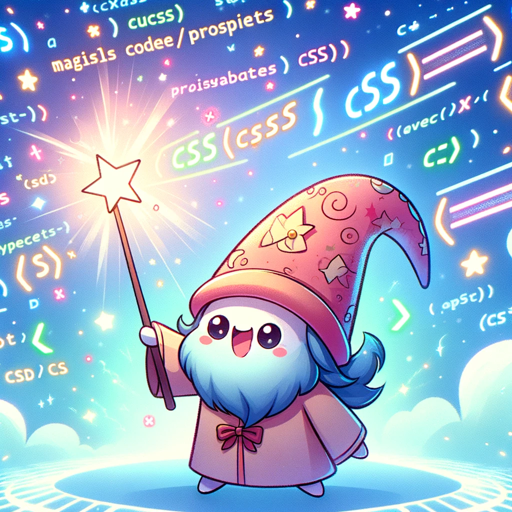HueForge Optimizer-filament stack optimizer for 3D prints
AI-powered filament layering for optimized 3D prints
How can I improve this image for hueforge printing?
What layer settings should I use for this hueforge print?
Can you analyze this image for hueforge printing?
Suggest adjustments for a better hueforge print.
Related Tools
Load More
Unity ++
Unity and C# Expert with Official Ebooks - 2024
You TubeOptimizer
Optimize YouTube Videos, Rank & SEO for your Channel | Optimize titles, tags, and descriptions for explosive channel growth.

Code Optimizer
I optimize code for better performance, primarily with respect to runtime. Input code!

Optimization
Expert in optimization methods and applications

CSS Wizard
Crafting stylish CSS for your web apps with a touch of magic!
Floor Plan Optimization Assistant
Help optimize floor plan, for better experience, please visit collov.ai
20.0 / 5 (200 votes)
Introduction to HueForge Optimizer
HueForge Optimizer is a specialized tool designed to assist in the creation of multi-layer 3D prints that rely on distinct colors and varying degrees of light transmissivity. The main objective of the tool is to optimize the arrangement of filament layers to achieve precise color blending, light transmission, and desired visual effects. HueForge Optimizer is particularly valuable for designers and makers working with 3D printed models that require delicate color transitions, such as stained glass effects, artistic pieces, or functional parts that manipulate light. For example, if a designer wants to create a stained glass effect using various filament colors, the tool helps organize the layers and suggest how thick each should be to achieve the right hue and light diffusion. The optimizer provides a clear table showing the stack order, colors, transmissivity values, and other parameters, ensuring a reliable and repeatable process for producing these types of prints.

Main Functions of HueForge Optimizer
Color Layer Optimization
Example
A user wants to create a gradient effect from dark blue to light cyan. The optimizer calculates the correct order and thickness of filament layers to create the smoothest transition between these colors.
Scenario
In a scenario where a lamp shade is being 3D printed to give off a gradient glow when illuminated, the tool determines the most effective stacking of transparent and translucent filaments to achieve this effect without abrupt color changes.
Light Transmissivity Adjustment
Example
A user wants a part of their 3D printed object to allow more light to pass through while maintaining a specific color. The tool adjusts the transmissivity levels by layering different filaments to control the light diffusion.
Scenario
When designing a light-diffusing cover for an LED fixture, the optimizer calculates how much light will pass through each filament combination and adjusts the layers accordingly to meet the desired light output while preserving the aesthetic.
Layer Thickness and Material Combination Suggestions
Example
The optimizer suggests using two layers of a translucent filament with a transmissivity of 40% and one layer of a clear filament with a transmissivity of 90% to achieve the perfect balance between color and transparency.
Scenario
For a 3D printed artistic window panel, the user wants a specific part to display a rich purple hue with moderate translucency. The optimizer suggests a combination of filament brands and layer thicknesses to achieve this effect, ensuring the model looks as intended when illuminated.
Ideal Users of HueForge Optimizer
3D Printing Enthusiasts and Hobbyists
This group benefits from the HueForge Optimizer as it helps them explore creative and complex color effects in their projects. The optimizer makes it easier for them to experiment with color combinations and transmissivity levels without needing extensive knowledge of material science. Whether designing decorative objects, customized accessories, or small-scale prototypes, these users will find the optimizer invaluable for achieving professional-grade results in their prints.
Professional Designers and Artists
Designers and artists specializing in 3D printed art installations, custom lighting projects, or display pieces can use the optimizer to fine-tune the visual qualities of their work. The optimizer allows them to achieve precise control over color transitions and light effects, making it ideal for applications where aesthetics are paramount. This tool supports creative professionals who want to push the boundaries of what’s possible with 3D printing, particularly in terms of color layering and light interaction.

Guidelines for Using HueForge Optimizer
Step 1
Visit aichatonline.org for a free trial without login; no need for ChatGPT Plus to start using HueForge Optimizer.
Step 2
Upload or input your filament data, including brand, color, transmissivity, and type. Make sure to organize your filament details clearly for the best results.
Step 3
Choose your print type (e.g., artistic, functional, or layered effects) and adjust parameters like color fidelity, opacity, and material layering to suit your project.
Step 4
Use the optimizer to calculate the ideal layer arrangement. It will suggest the optimal stack order, number of layers, and other critical settings.
Step 5
Download or save the recommended configuration for your 3D printer or filament stack assembly. Make any last adjustments based on your final aesthetic or performance goals.
Try other advanced and practical GPTs
LLM Course
Empower Your AI Knowledge with Interactive Learning

Lustrador
Enhance your prompts with AI precision.

Image Generator
Transform Your Ideas into Images with AI

Developer
AI-powered developer tool for all your coding needs.

Progress Notes AI™
AI-Powered Clinical Documentation Simplified

Presentation PRO +
AI-Powered Presentation Creation Tool

Artsy Intelligence
AI-Powered Creative Solutions for All

Pix Muse
AI-driven images from ideas to art.

VocabMaster
AI-powered vocabulary memorization made simple

Prof. Deutsch
AI-powered proofreading for Swiss German.

Your Writing Assistant, Simplified
AI-powered writing made simple.

Election 2024 Simulator
AI-powered debates, hilarious campaigns.

- 3D Printing
- Filament Stacking
- Color Optimization
- Multi-Material
- Layer Arrangement
Common Questions About HueForge Optimizer
What is HueForge Optimizer used for?
HueForge Optimizer helps users create highly optimized filament stack arrangements for color 3D printing projects. It calculates the ideal layering of filaments to achieve desired aesthetic or functional outcomes based on transmissivity, color, and material properties.
Do I need any special software to use HueForge Optimizer?
No special software is required. The tool operates through a web interface and provides a user-friendly experience. Simply input your filament data, adjust the settings, and let the optimizer calculate the ideal print configuration.
What types of projects can benefit from HueForge Optimizer?
The optimizer is perfect for artistic projects, color-critical printing, multi-material designs, and advanced functional prototyping. It ensures the right balance between color fidelity, translucency, and structural integrity in prints.
How does the optimizer determine the best layer stack order?
HueForge Optimizer analyzes the transmissivity, color properties, and type of filament materials, calculating the best layer stack to achieve your desired print outcome. It optimizes for color blending, opacity, and overall print quality.
Can HueForge Optimizer be used for non-color-specific 3D prints?
Yes, while it excels in color optimization, it also helps with structural layer optimization for functional prints, ensuring a robust and well-balanced layer configuration even when color isn't the primary concern.